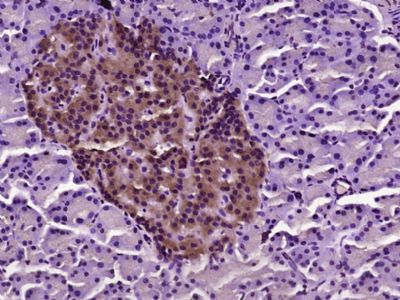Tumor Markers
Mucins are high molecular mass, highly glycosylated macromolecules that are the major components of mucus secretions. MUC5B is a salivary mucin that is thought to contribute to the lubricating and viscoelastic properties of whole saliva. It is composed of 14.9% protein, 78.1% carbohydrate, and 7% sulfate (Troxler et al., 1995 [PubMed 8554565]).[supplied by OMIM]
Function:
Gel-forming mucin that is thought to contribute to the lubricating and viscoelastic properties of whole saliva and cervical mucus.
Subcellular Location:
Secreted.
Tissue Specificity:
Expressed on surface airway epithelia. Expressed mainly in mucous cells of submucosal glands of airway tissues. Highly expressed in the sublingual gland. Also found in submaxillary glands, endocervix, gall bladder, and pancreas.
Post-translational modifications:
Highly glycosylated. SLC, N- and O-glycosylated. SLCmannosylated in the Cys-rich subdomains probably on the first Trp residue of the WXXW motif. Highly O-glycosylated in the Ser/Thr-rich tandem repeat (TR) region. The repeat region is about 59% O-glycosylated with a high abundance of NeuAc(2)Hex(1)HexNac1-ol.
Similarity:
Contains 1 CTCK (SLCterminal cystine knot-like) domain.
Contains 3 HAT repeats.
Contains 3 TIL (trypsin inhibitory-like) domains.
Contains 3 VWFC domains.
Contains 4 VWFD domains.
SWISS:
Q9HC84
Gene ID:
727897
Database links:
Entrez Gene: 727897 Human
Omim: 600770 Human
SwissProt: Q9HC84 Human
Unigene: 523395 Human
| Picture |
Paraformaldehyde-fixed, paraffin embedded (Rat pancreas); Antigen retrieval by boiling in sodium citrate buffer (pH6.0) for 15min; Block endogenous peroxidase by 3% hydrogen peroxide for 20 minutes; Blocking buffer (normal goat serum) at 37°C for 30min; Antibody incubation with (MUC5B) Polyclonal Antibody, Unconjugated (SL23915R) at 1:400 overnight at 4°C, followed by operating according to SP Kit(Rabbit) (sp-0023) instructionsand DAB staining.
|
|
|
